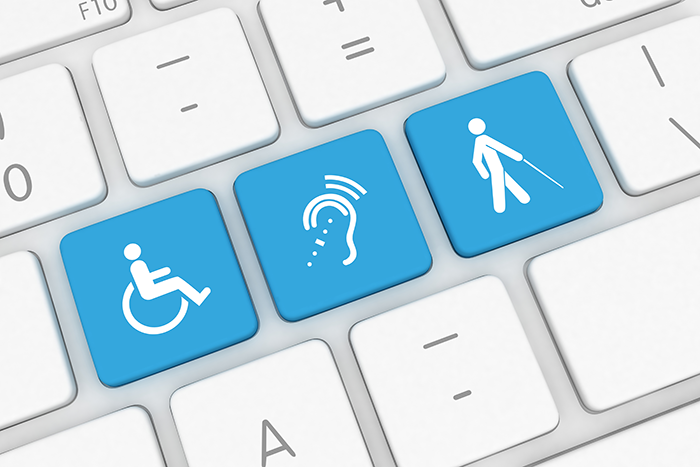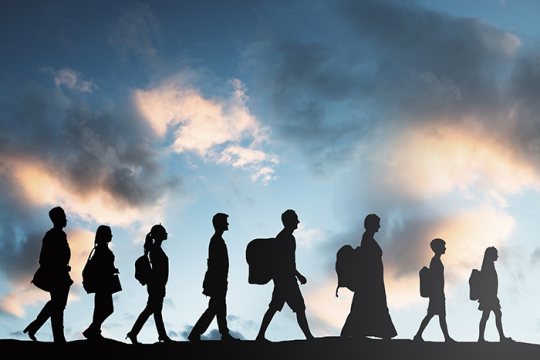
Last year during services, my mom leaned over and whispered to me, "I can't see the screen. What prayer are we on?"
In my Reform congregation, we had shifted to using a visual t'filah - projecting the service text on a screen instead of (or alongside) prayer books. I've always loved it: with no books in hand, the congregation looks up together. So, I whispered the answer to my mom and thought nothing of it.
Since joining the team at JBI Library, I can't stop revisiting that moment.
I now know that nearly one in five adults live with significant vision loss. On any given Shabbat, as many as 20% of those attending may struggle to see printed words, regardless of whether they're on a page or a projection. Many may not attend at all because the barriers feel too high.
This affects Jewish youth too. About 3% of U.S. children under 18 are blind, and 5%-15% have reading disabilities. If we expand our survey to those with physical, developmental, and cognitive disabilities, we find that more than 1 in 4 of us face one of these challenges.
The slides that felt natural and freeing to me were, for my mom, isolating. She is not alone; I now hear story after story of people who struggle to find a place in Jewish communal life because of a disability. At best, our inclusion is inconsistent. At worst, we are shutting people out.
Rabbi Julia Watts Belser, in "Loving Our Own Bones: Disability Wisdom and the Spiritual Subversiveness of Knowing Ourselves Whole," retells a Talmudic story about the sins of Sodom that ultimately led to its destruction. Travelers arriving in Sodom were offered a single bed. If a guest was too tall, their feet were cut off; if too short, they were stretched to fit.
She writes:
"I take this story as a vivid account of ableism, of how it brutalizes flesh and bone. This is a story about the violence that follows when we force people to fit complex, unruly bodies and minds into a simple, one-size-fits-all society; when we demand that everyone walk up a few flights of stairs, read the fine print, and peer at the PowerPoint; when we assume that everyone's body and mind must fit the same bed-or else, face the hatchet."
Her words haunt me. How many times in my work with synagogues and Jewish organizations did I believe I was creating a welcoming space, only now to realize my choices reflected ignorance or ableism? When did I rely solely on projected slides or small-print handouts, post materials without image descriptions, or assume everyone could hear when I wasn't using a microphone? When gathering a group, how often did I forget to ask, "Do you need large print, an ASL interpreter, Braille, a larger chair, a quiet room, fidgets, tactiles, or other tools to fully participate and enjoy this experience?"
JBI Library board member Rabbi Gabrielle Cohn shared in a recent interview:
"One of the biggest misconceptions in Jewish spaces around disability and inclusion is that communities often pat themselves on the back for being inclusive of one type of disability and then claim they are fully inclusive."
So, what can we do?
First, Enter with a Questioning Mind
A friend with low vision recently shared with me how her synagogue kindly prepared a large-print prayerbook for her. But large print wasn't useful; she could only see a small square of text at a time. Her story reminds us to approach each person and situation with humility and curiosity, asking rather than assuming. As Rabbi Cohn teaches, "To truly achieve inclusion, we need to talk to people with a wide array of disabilities to understand what will best help them feel welcome."
Second, Prepare
Accessibility should be built into the fabric of community life. Preparation means creating systems so people don't have to scramble or apologize when needs arise. A simple step is to add language to event announcements that explains how to access accommodations. This opens the door for people to share their needs, lets them know who can support them, and ensures you respond with readiness and confidence. There are certain materials and tools that you can have ready so that you are prepared when someone asks. JBI Library provides prayerbooks and sacred text from across the Jewish world in jumbo print and braille. Just give us a call or send us an email - we are happy to help you. As a mother of a daughter who is blind recently shared: "Being able to walk into any synagogue and know that my daughter can fully participate in services and read with the community-that is the dream." Having a process in place and materials ready turns belonging from a promise into a reality.
Third, Anticipate
Think ahead about the range of participants' needs and design experiences that are seamless and barrier-free for everyone. Ask yourself: Which parts of this experience could be difficult for someone with low vision or blindness; is hard of hearing or Deaf; or has sensory sensitivities, dyslexia, or mobility challenges? Whether you are planning a Shabbat service, a small gathering in your home, or a family holiday celebration, consider how each moment can be accessible so that every person can fully engage, contribute, and feel a sense of belonging.
Our tradition offers a model: Abraham and Sarah's tent was open on all sides, with the couple rushing to greet every traveler. Their hospitality was unconditional, embracing all. If our doors are open but our spaces are not accessible, we are only halfway there. True belonging means ensuring that every person can participate, learn, and celebrate fully. May our communities rise to that calling with the radical hospitality of Abraham and Sarah and the deep conviction that every member of our people deserves a seat at the table, a voice in prayer, and a home in Jewish life.
As we strive to ensure every person can fully participate and feel a sense of belonging, take the URJ's Equity Indicator to assess and improve your community's accessibility efforts.
Related Posts

Honoring Transgender and Nonbinary Community Members’ Infinite Value

Nine Things to Consider When Creating an Inclusive Security Plan


